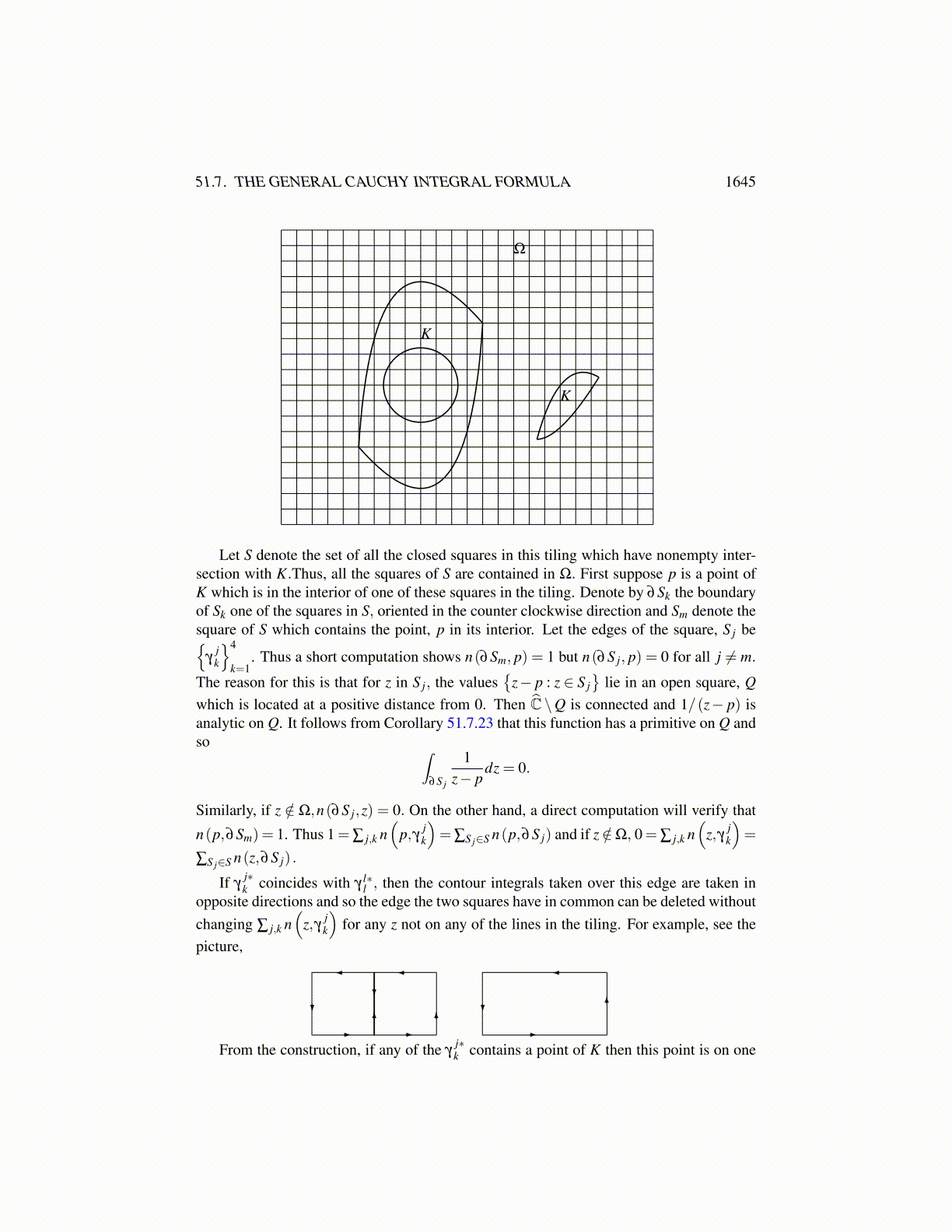
51.7. THE GENERAL CAUCHY INTEGRAL FORMULA 1645
Corollary 51.7.20 Let Ω be an open set and let γk : [ak,bk]→Ω, k = 1, · · · ,m, be closed,continuous and of bounded variation. Suppose also that ∑
mk=1 n(γk,z) = 0 for all z /∈ Ω.
Then if f : Ω→ C is analytic, ∑mk=1
∫γk
f (w)dw = 0.
Proof: This follows from Theorem 51.7.19 as follows. Let
g(w) = f (w)(w− z)
where z ∈Ω\∪mk=1γk ([ak,bk]) . Then by this theorem,
0 = 0m
∑k=1
n(γk,z) = g(z)m
∑k=1
n(γk,z) =
m
∑k=1
12πi
∫γk
g(w)w− z
dw =1
2πi
m
∑k=1
∫γk
f (w)dw.
Another simple corollary to the above theorem is Cauchy’s theorem for a simply con-nected region.
Definition 51.7.21 An open set, Ω ⊆ C is a region if it is open and connected. A region,Ω is simply connected if Ĉ \Ω is connected where Ĉ is the extended complex plane. In thefuture, the term simply connected open set will be an open set which is connected and Ĉ\Ω is connected .
Corollary 51.7.22 Let γ : [a,b]→ Ω be a continuous closed curve of bounded variationwhere Ω is a simply connected region in C and let f : Ω→ X be analytic. Then∫
γ
f (w)dw = 0.
Proof: Let D denote the unbounded component of Ĉ\γ∗. Thus ∞ ∈ Ĉ\γ∗. Thenthe connected set, Ĉ \Ω is contained in D since every point of Ĉ \Ω must be in somecomponent of Ĉ\γ∗ and ∞ is contained in both Ĉ\Ω and D. Thus D must be the componentthat contains Ĉ \Ω. It follows that n(γ, ·) must be constant on Ĉ \Ω, its value being itsvalue on D. However, for z∈D,n(γ,z) = 1
2πi∫
γ1
w−z dw and so lim|z|→∞ n(γ,z) = 0 showingn(γ,z) = 0 on D. Therefore this verifies the hypothesis of Theorem 51.7.19. Let z ∈Ω∩Dand define g(w)≡ f (w)(w− z) . Thus g is analytic on Ω and by Theorem 51.7.19,
0 = n(z,γ)g(z) =1
2πi
∫γ
g(w)w− z
dw =1
2πi
∫γ
f (w)dw.
This proves the corollary.The following is a very significant result which will be used later.
Corollary 51.7.23 Suppose Ω is a simply connected open set and f : Ω→ X is analytic.Then f has a primitive, F, on Ω. Recall this means there exists F such that F ′ (z) = f (z)for all z ∈Ω.